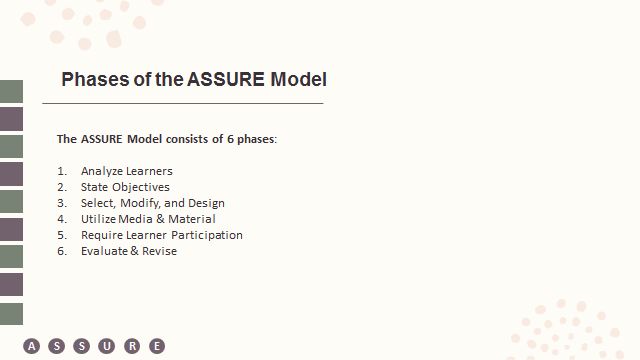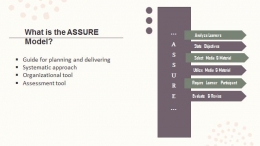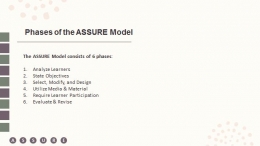ASSURE is an instructional design model that has the goal of producing more effective teaching and learning. The ASSURE model was developed by Heinich, Molenda, Russell. ASSURE model contains six steps and the letters in ASSURE form an acronym.
ASSURE (is an acronym of Analyze, State objectives, Select materials, Utilize materials, Require learner responses, Evaluate) model is among ISD models. It consists of step by step approaches to create a lesson that effectively integrate the use of technology and media to improve students' learning (Smaldino, 1996). ASSURE model uses a standard research based approach to lesson design which is most likely suitable to any school or district lesson plan pattern (Smaldino et al, 1996).

The ASSURE model is just one strategy to effectively integrate technology into curriculum. Some teachers will create an ASSURE poster to help them remember the steps of the model. The ASSURE model are second nature and that will lead teachers to better teaching. As teachers revise lessons from year to year, it must be new and emerging technologies that might be more effective.
The Assure Model has some aims, those are:
1. Help for how to plan, identify, set goals, choose methods and materials, and evaluate.
2. Planning a systematic learning system by integrating technology and media. The learning becomes more effective and meaningful for students.
3. Help to solve problems and help make it easier to convey learning cause learning process is complex process and is a system that needs to be done with systematic approach.

In implementing ASSURE Model of Instructional Design, the teacher should follow these significant characteristics:
- Analyze learners
- State objectives
- Select, modify, and design
- Utilize media & material
- Require learner participation
- Evaluate & revise
1. Analyze Learners
The learners should be studied prior to the conception of the design. Learners' skills, prior knowledge, attitude, age, grade and learning style must be taken into consideration. According to Hap Aziz, "In order to select the best media and technology for the delivery of instructional content, it is essential to identify and analyze the audience". (Hap Aziz, OIT. 1999).
The instructor will analyze learners based on three features:
- General characteristics, which include the number of students at the class, age, level, gender, socio economic status of the students, exceptionality, cultural and ethical diversity of the learners.
- Entry competencies, this means the description of knowledge which the teacher expects the learners have known. Like knowledge, skills and attitudes about the topic.
- Learning style, this refers to psychological differences of the learners that determine how a person perceives, interacts with and responds emotionally to the learning environment. This includes multiple intelligence, perceptual preference and strength, information processing habits (concrete sequential learners, concrete random, abstract sequential and random sequential learners), motivation, and physiological.
2. State Objectives and Standards
The lesson objectives must be clear and sound. The instructor must state what the learner will achieve in the end. The most important objective can be summarized as follows: objective about intended audience, their learning behavior, learning conditions such as equipments, maps, dictionaries, note taking and the degree of proficiency of a learner to be eligible to continue further. Statement of the objective also involves systematic planning and procedure (Daniel Callison 2002).
The instructor should be able to observe students behavior as a result of the model. This is very important for further evaluation of the model. According to Gagne, "It is necessary to translate the needs and goals into objectives that are sufficiently specific to guide the instructor in teaching and the learner in studying" Gagne, R. M. Briggs, L. J, & Wager, W.W. (1992).
3. Select Media, Technology, and Materials
Smaldino (1996) suggested the following criteria for selecting technology and media: 1) Alignment with standard outcome and objective 2) Accurate to the current information 3) Age appropriateness 4) Interest level and engagement 5) Technical quality 6) Ease for use 7) Bias free 8) User guide and direction
Relevant media and content materials such as sound, graphics, text animations and videos must be selected for effective learning outcomes. "As we know, instructional technology the convergence of computer and communications technology within the realm of teaching and learning has already had profound effects on education at all levels." (Philip H. Swain 2003)
The duty of the instructor is to bridge the new technology with the existing materials. Instructors must understand how technology is used to educate learners. Because of the exciting attributes of technology the question of what to teach and how to teach must be addressed (Judith J. Lambrecht 1999).
4. Utilize Technology, Media, and Materials
This step involve the role of teacher on planning how he is going to utilize technology, media, and materials to help students achieve the learning objectives. In this matter, the teachers will consider 5P which means; preview the materials, prepare the materials, prepare the environment, prepare the learners, and provide the learning experience. The teacher should appropriately provide the interesting material to attract student in learning. Beside that, the equipments and condition of classroom must be suitably considered such as lights and other facilities to support the teaching learning activity in a course.
5. Require Learners Performance
The teacher should prepare substantial needs for students to practice the material. The learners should be given the sufficient response to improve their skills and to reduce further errors. This give a chance for learners to communicate with the teacher. Therefore, they can participate in critical thinking and problem solving after mastering a variety of meaningful lessons.
6. Evaluate
Evaluating the entire lessons is the final step of this model. This is nesessary for further improvements in learning. Teacher must evaluate to see whether his/her objectives are achieved. Before presenting the lessons again, appropriate revision and correction must be done. This evaluation is not limited to determine students' achievement of the lesson outcomes, but also to examine the entire instructional process and the impact of using technology and media in the lesson. Wherever there is discrepancy between learning and objective, the teacher will revise the lesson plan to address the area of concern (Smaldino, 1996).
References:
Hap Aziz. (1999). Assure Learning Through the Use of the ASSURE Model. Office of Information Technology, OIT. Valencia Community College.
Ahmad Abdullahi Ibrahim. (2015). Comparative Analysis between System Approach, Kemp, and ASSURE Instructional Design Models. International Journal of Education and Research, 3(12), 266.
Daniel Callison. (2002). Instructional Models: (Part 3). School Library Media Activities Monthly. Baltomore, 19(3), 36.
Gagne, R. M. Briggs, L. J, & Wager, W.W. (1992). Principles of Instructional Design, 4th edition, Forth Worth, TX: Harcourt Brace Jovanovich College Publishers.
Smaldino, S.E. (2006). Instructional Technology and Media for Learning, UK; Upper Saddle River.
Philip H. Swain. (2003) Psychology of Learning for Instruction, 2nd edition/ The Art of Changing the Brain: Enriching the Practice of Teaching by Exploring the Biology of Learning. Journal of Engineering Education, Washington, 92(4), 283.
Judith J. Lambrecht. (1999). Teaching Technology-related Skills. Journal of Education for Business, 74(3), 144.
Ahmad Abdullahi Ibrahim. (2015). Comparative Analysis between System Approach, Kemp, and ASSURE Instructional Design Models. International Journal of Education and Research, 3(12), 267.
Baca konten-konten menarik Kompasiana langsung dari smartphone kamu. Follow channel WhatsApp Kompasiana sekarang di sini: https://whatsapp.com/channel/0029VaYjYaL4Spk7WflFYJ2H








